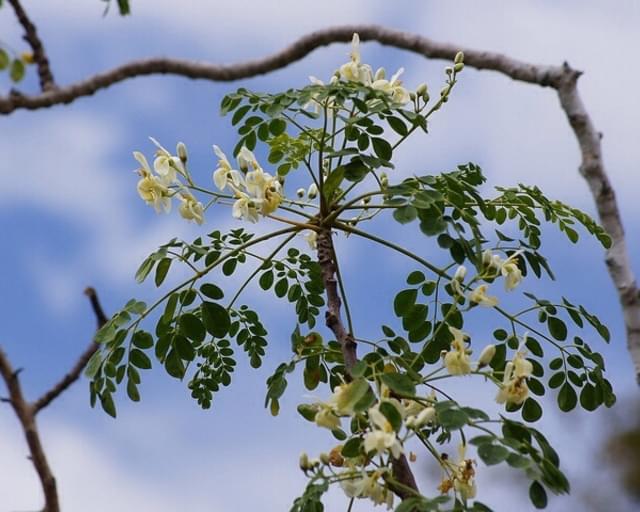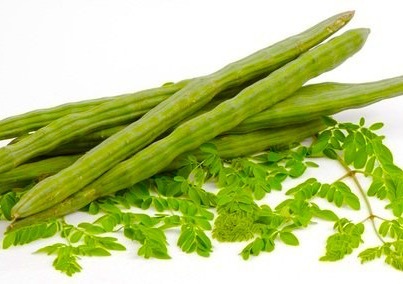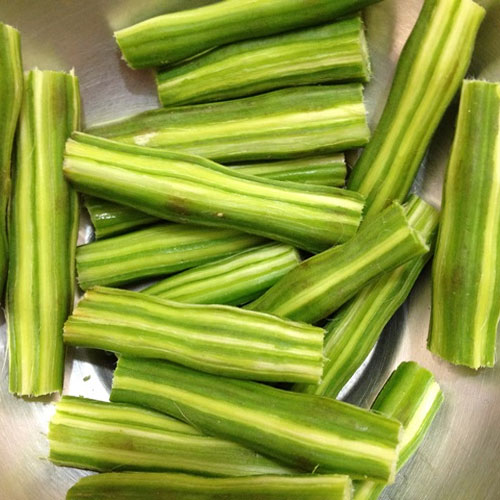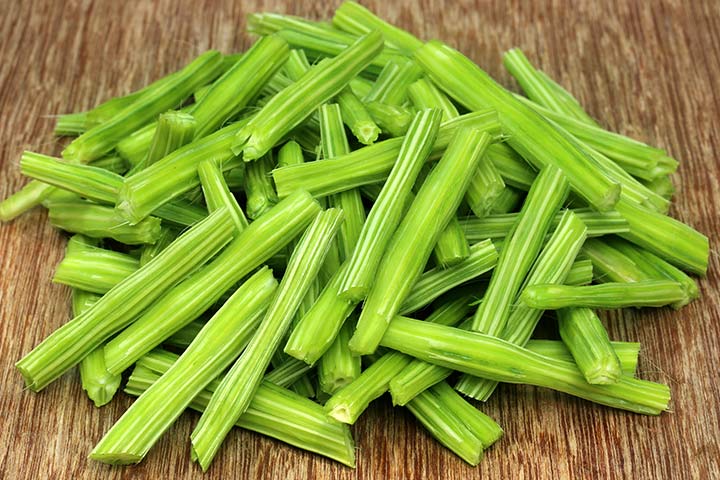Saijan – The magic tree
 For over thousands of years the Saijan plant has been praised for its numerous health benefits. Given it has a rich blend of healthy antioxidants and bioactive plant compounds, the value of the plant was discovered and promoted for the benefit of the population. This was done by former Minister of Agriculture Dr. Ptolemy Reid. In addition, the plant is a beneficial treatment for many diseases.
For over thousands of years the Saijan plant has been praised for its numerous health benefits. Given it has a rich blend of healthy antioxidants and bioactive plant compounds, the value of the plant was discovered and promoted for the benefit of the population. This was done by former Minister of Agriculture Dr. Ptolemy Reid. In addition, the plant is a beneficial treatment for many diseases.
Saijan is an ornamental tree with added nutritional and health value. It is quick growing and can be controlled by judicious trimming and pruning to remain shrubby enough to be accommodated in even the most modest sized backyard.
Where Did It Came From
Saijan was known and widely used by the Romans, Greeks and Egyptians as a cure for a wide range of ailments. It is a tree which originated in the foothills of the Himalayas in India about 5000 years ago. Today, Saijan’s health benefits are widely recognised.
Scientific Classification
The scientific classification of Saijan is “Moringa Oleifera”.
Features
Saijan is also known as the miracle tree, the multipurpose tree, the drumstick tree, the clarifier tree, and the tree of life. It has small, rounded leaves and virtually all parts of the plant are used for various purposes. This includes leaves, fruits, flowers and roots of the tree.
7 Benefits Of Eating Saijan
 Edema: Saijan fights against Edema and its root extract possesses anti-inflammatory qualities.
Edema: Saijan fights against Edema and its root extract possesses anti-inflammatory qualities.- Liver Protection: Due to the phytochemicals found in Saijan, eating it’s leaves, protects against damage by anti-tubercular drugs.
- Weight loss: It combats obesity because of its low-fat quality and converts food into energy rather than storing it as fat.
- Promotes Healthy hair and skin and slows up premature aging: For this reason, it is used in the production of cosmetics and skin-care products.
- Cancer therapy: Saijan is valued in tumour therapy as it is an anti-cancer. It is particularly effective with ovarian cancer.
- Neurodegenerative Diseases: The effectiveness of Saijan has been very valuable in the treatment of neurodegenerative diseases such as dementia.
- Cardiovascular protection and diabetes: Saijan extracts are helpful in the protection of myocardial or cardiac damage, due to the presence of its powerful antioxidants. They also exert anti-diabetics effects in the treatment of diabetes mellitus.
There are several other diseases which Saijan could be used to treat or counter. In addition to its medical value, Saijan has great nutritional value and is used as a food.
Nutritional facts
Saijan is used in certain parts of the world to help poor nations fight food insecurity and malnutrition. As such, the tree is known as the “Magic Tree”. Native to Northern India, this tree which include the roots, bark, leaves, flowers, fruit, seeds and oil, has been used in Ayurveda medicine for centuries. Ayurveda medicine is a system of traditional medicine native to India. What has caught the attention of scientists all over the world is not just the number of nutrients found in Moringa but the high amounts of the various nutrients it contains.
In the fresh and dried form of the plant, a lot of the nutrients are found in the leaves. It is therefore more concentrated in the dried form. This is as a result of having the fresh leaves dried in the shade and then pounded to a powder.
In the powder form, gram for gram, Moringa is said to have:
- 10 times more Vitamin A than carrots
- 50 percent more Vitamin C than oranges
- 15 times more potassium than bananas
- 17 times more calcium than milk
- 25 times more iron than spinach
- 9 times more protein than yogurt
In the fresh form, gram for gram, Moringa is said to have:
- 3 times more iron than spinach
- 2 times more protein than yogurt
- 7 times more Vitamin C than oranges
- 4 times more Vitamin A than carrots
- 4 times more calcium than milk
- 3 times more potassium than bananas
The leaves of Saijan can be eaten as greens (spinach, callaloo), in salads, curries, pickles etc. Moringa is one of the few plants that contains all of the 9 essential amino acids the body cannot produce. The pod or the saijan vegetable itself is a chock full of amino acids.
How to Use Saijan
If you have access to a moringa tree, you can use the fresh leaves in your meals of which have a flavour similar to radish. The leaves are used for flavouring dhals and curry, lending their intense aroma to these dishes while ensuring nutrition security. It is an element often ignored when we talk of food security. Food security is not only about calories consumed but also about nutrition received. When we have any dish using drumsticks or their leaves we are sure that we are being truly nourished.
Saijan can be tossed like a salad, blended into smoothies, or steamed6 like spinach.
Another option is to use moringa powder, either in supplement form or added to smoothies, soups, and other foods for extra nutrition. Moringa powder has a distinctive “green” flavour, so you may want to start out slowly when adding it to your meals.
You can also use organic, cold-pressed moringa oil.
How To Make Saijan Bhajee
Saijan In Guyana
 In Guyana, the young Saijan sticks are boiled in soups or in dhal or cooked in curries. The leaves are also used as a leafy vegetable (bhaji). As a food, it contains a great range and amounts of essential proteins and vitamins. Vitamins it contains include: Vitamin A, B1, B2, B3, B6 and C. Its mineral wealth includes calcium. It also contains very low amounts of fats and offers no harmful cholesterol.
In Guyana, the young Saijan sticks are boiled in soups or in dhal or cooked in curries. The leaves are also used as a leafy vegetable (bhaji). As a food, it contains a great range and amounts of essential proteins and vitamins. Vitamins it contains include: Vitamin A, B1, B2, B3, B6 and C. Its mineral wealth includes calcium. It also contains very low amounts of fats and offers no harmful cholesterol.
In poverty-stricken regions where malnutrition is endemic, it is promoted by various humanitarian organisations, one of the reasons being that it grows easily and rapidly. However, it was made known that the National Agricultural Research & Extension Institute (NAREI) was looking into the cultivating of Saijan since it could be an important nutritional input to Guyana and could also be an important crop to export. Anyone could however easily grow a Saijan tree in his/her backyard. The effective curative and medical uses of the tree as well as its great nutritional value and its great versatility have resulted in the Saijan being known as “The Miracle Tree.”
References
- http://guyanachronicle.com/2017/05/21/saijan-the-miracle-tree
- https://www.kaieteurnewsonline.com/2017/05/24/the-saijan-tree-should-be-given-prominence-as-a-nutritional-powerhouse/
- https://www.stabroeknews.com/2013/the-scene/tastes-like-home/05/18/the-magic-tree/
- https://www.facebook.com/EssentialcareGuyana/photos/moringa-the-miracle-plantwe-are-what-we-eat-so-eat-healthythe-miracle-plant-is-c/1766791866882939/
- https://www.healthline.com/nutrition/6-benefits-of-moringa-oleifera
- Main Image Source: https://www.momjunction.com/articles/drumstick-during-pregnancy_00380013/








1 Comment